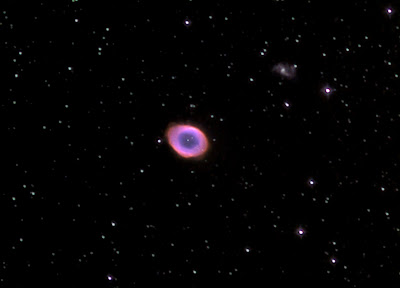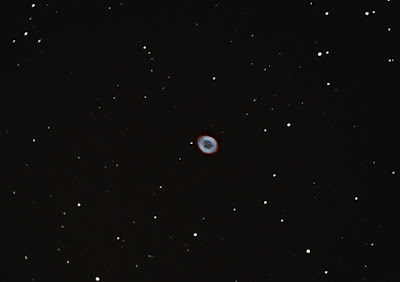
The Ring Nebula in Lyra is another old favourite of astroimagers. The above image (click on the image to emlarge) was taken in September 2007 with the SXV-H9 camera and the Vixen VMC200L (200mm/f9) and was assembled from 20 X 60 second exposures in white light as a luminance frame, with 30 X 60 exposures through a Ha (red channel) filter, with a further 30 X 60 exposures through an O3 (blue channel) filter, all in 2x2 binned mode. The raw frames for each channel were stacked and contrast-adjusted in AIP4Win, then exported as TIFs to Paint Shop Pro, where I used the colour masking technique in "Layers" as described earlier to assemble the final colour image as above.
I had a little difficulty focussing and wasn't too happy with the final star images. After the imaging session, I replaced the CCD with an eyepiece and found that the 'scope was actually rather out of collimation. This was the first time in five years that I had needed to tweak the collimation on the VC200L - it has a double set of push-pull screws to adjust both primary and secondary mirrors, which tend to lock the mirrors in place and keep collimation pretty well. However, I remembered that I had hastily abandoned my last imaging session when a sudden rainstorm had hit, and that I had to remove my rig from its platform and wheel it to shelter pretty quickly when the first big drops of rain started to fall. I guess the hurried lumping and bumping about hadn't done the optics much good.
These compound VC200L scopes aren't the easiest things to collimate, but fortunately there's a good guide here. A few tweaks with an Allen key on the primary mirror adjustors soon got the star images sharp again, and I plan to return to M57 and try to get a better resolved image.
Even so, the image above still shows the 15th magnitude barred spiral galaxy IC1296 to the northwest of M57 - most images you see don't go deep enough to evidence it, especially those taken with digital cameras.
My own earlier (August 2002) effort with a digital camera (afocal projection using the VC200L and a 25mm eyepiece) is shown below (click to enlarge).

This is an average of two 60 second exposures taken at ISO400 and processed in PSP. I haven't adjusted the colours at all, only the contrast and brightness. Whilst the digital camera is noticably less senstive than the SXV-H9 and shows fewer stars, the image itself is still quite satisfying.



No comments:
Post a Comment